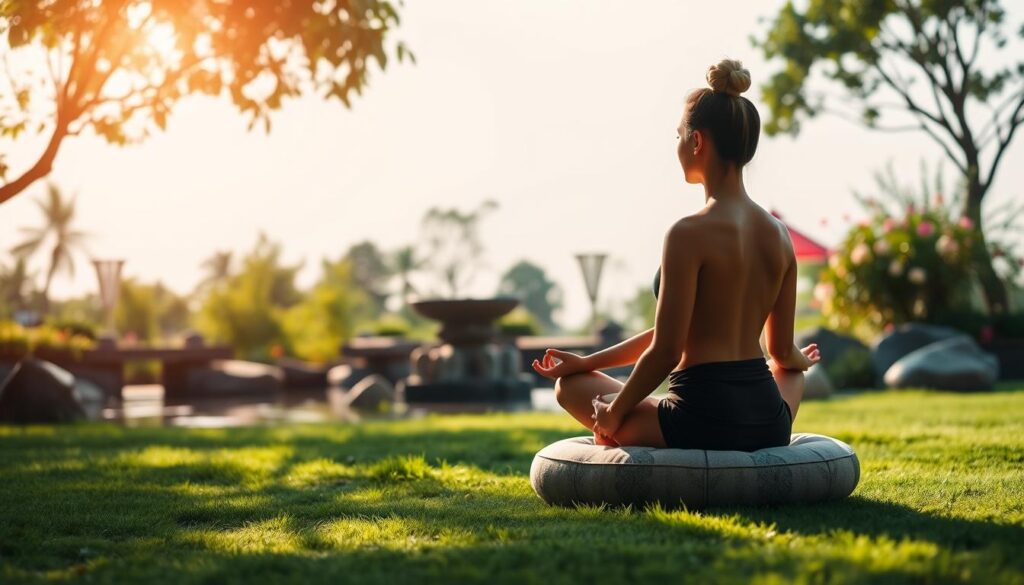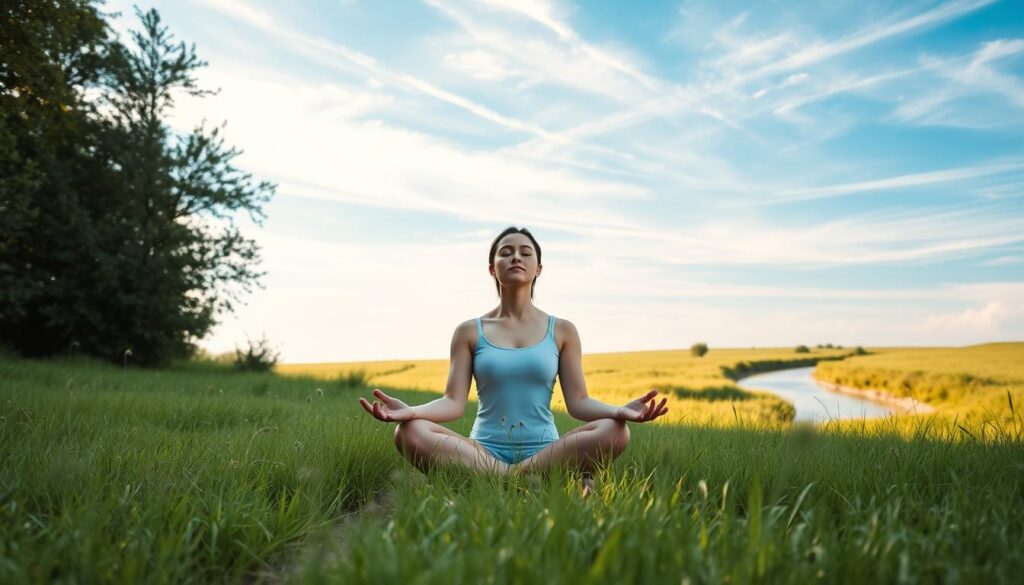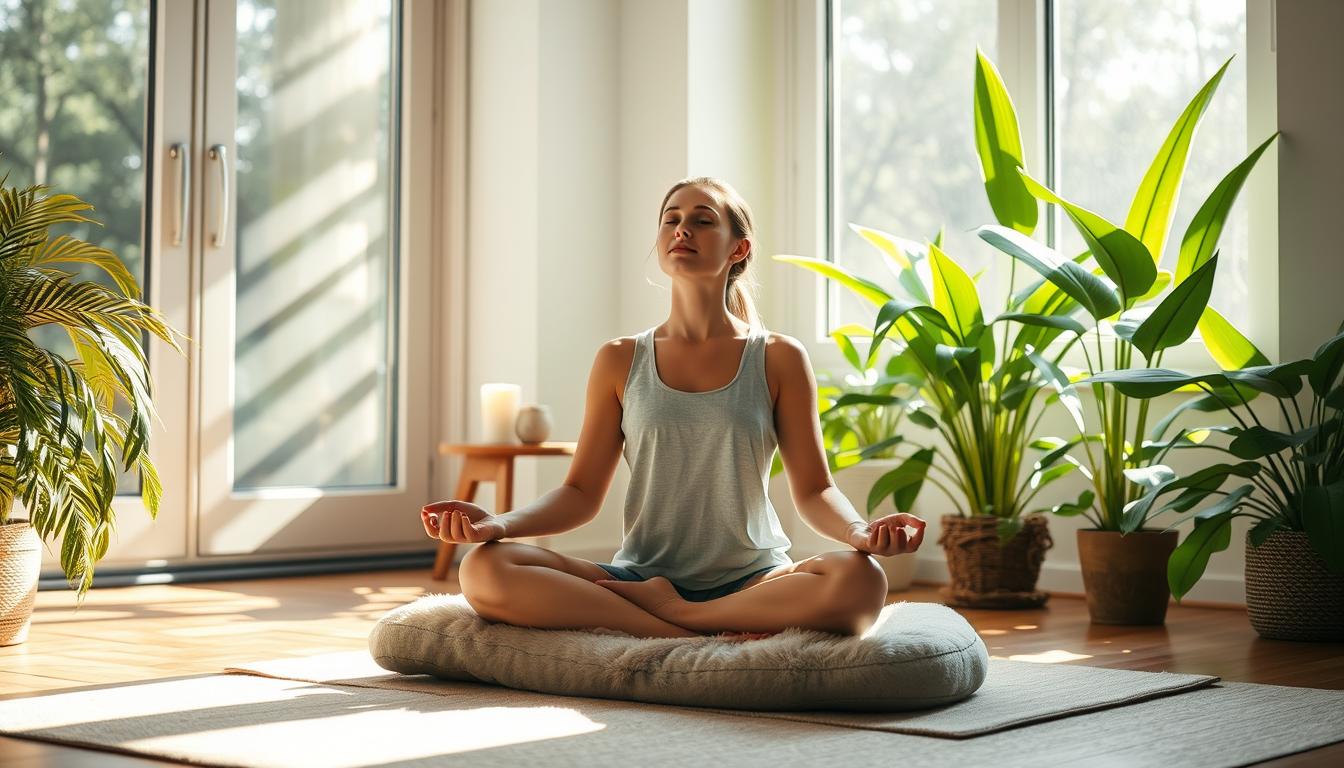As we navigate the chaos of our daily lives, it’s easy to get caught up in the hustle and feel like we’re constantly running on a never-ending treadmill. I’ve been there too – overwhelmed, stressed, and unsure of how to stop the noise. That’s where meditation comes in – a simple yet powerful practice that can bring some much-needed calm into our lives.
For beginners, meditation is not about achieving some sort of perfect state; it’s about being present and developing awareness. When we start practicing mindfulness, we can expect to feel less stressed and more focused. In this guide, we will explore the basics of meditation, how to create a meditation space at home, and how to build a sustainable practice that works for you – helping you to get started on this journey.
Key Takeaways
- Understanding the basics of meditation and its benefits for beginners
- Creating a dedicated meditation space at home
- Building a consistent meditation practice
- Addressing common misconceptions about meditation
- Starting your meditation journey with simple techniques
Understanding Meditation: What It Is and Why It Matters
Meditation isn’t just a practice; it’s a journey that invites individuals to explore the depths of their mind, fostering a deeper connection with themselves and the world around them. As we embark on this journey, it’s crucial to understand the essence of meditation and its far-reaching benefits.
Defining Meditation for Beginners
For those new to meditation, it can be defined as a practice where an individual focuses their mind on a particular object, thought, or activity to achieve a mentally clear and emotionally calm state. It’s about noticing your thoughts without judgment, rather than trying to empty your mind completely.
The Science-Backed Benefits of Regular Practice
Regular meditation practice has been backed by science to offer numerous benefits, including reducing stress, improving focus, enhancing emotional health, and promoting better sleep. By incorporating meditation into daily life, people can experience these benefits firsthand, leading to an overall improvement in well-being.
Dispelling Common Meditation Myths
Several misconceptions surround meditation, deterring some from trying it. Let’s address a few:
- Meditation doesn’t require completely emptying your mind of thoughts; it’s about noticing them.
- You don’t need to dedicate hours; even 5-10 minutes can be beneficial.
- Meditation is for anyone, regardless of their background or beliefs.
- Fidgeting or a wandering mind is normal and part of the learning process.
- You don’t need perfect silence or special equipment to meditate effectively.
Creating Your Meditation Space at Home
Transforming a corner of your home into a meditation sanctuary can be a game-changer for your mindfulness practice. It’s about creating an environment that fosters calmness and clarity.
Finding a Quiet, Comfortable Location
When selecting a spot for meditation, two things are crucial: comfort and the ability to maintain an upright posture. Sitting comfortably with good posture is more beneficial for your body than slumping. Using a meditation cushion can help achieve this. If you’re using a chair or bed, ensure it provides adequate support to keep you from sinking into it.
Essential (and Optional) Equipment for Beginners
For beginners, the right equipment can make a significant difference. A meditation cushion or a supportive chair is essential. Optional equipment includes items that can enhance your meditation experience, such as calming music or nature sounds, and scented candles or essential oils for a soothing atmosphere.
Setting the Right Atmosphere
To create a calming atmosphere, consider adjusting the lighting and temperature to comfortable levels. You can also use sounds like gentle music or nature sounds to create a peaceful ambiance. Some people find essential oils or scented candles helpful in enhancing their meditation practice. However, it’s crucial that the atmosphere supports your practice without becoming a distraction. Ultimately, your internal approach to meditation matters more than the external environment.
By thoughtfully creating your meditation space, you can cultivate a consistent and fulfilling meditation practice that brings peace and clarity to your mind.
Preparing Your Body and Mind for Meditation
As we dive into the world of meditation, it’s essential to prepare our body and mind for the practice. This preparation will help us create a solid foundation for our meditation journey, making it easier to establish a consistent and beneficial practice.
Choosing the Right Time to Meditate
When it comes to meditation, time is an important factor. We should choose a time when we are relatively free from distractions, such as early in the morning or right before bed. Some people prefer meditating during their lunch break or right after a workout. The key is to find a time that works for us and stick to it.
Proper Meditation Posture for Beginners
Maintaining the right posture is crucial for effective meditation. We can sit on a chair or on a cushion on the floor, whichever is more comfortable. We should keep our back straight, hands placed gently on our lap, and feet planted firmly on the ground. A good posture will help us stay alert and avoid physical discomfort during meditation.
Setting Realistic Expectations
As we start our meditation practice, it’s essential to set realistic expectations. Our mind will wander, and that’s okay. It’s normal to have thoughts during meditation. We should be kind to ourselves and acknowledge that it’s a process to cultivate a stable mind. With regular practice, we will get better at it.
Let’s take a look at some common challenges we might face when starting our meditation practice:
| Challenge | Why it happens | How to overcome it |
|---|---|---|
| Mind wandering | Our mind is used to constant thinking | Gently bring our attention back to our chosen meditation object |
| Physical discomfort | Unfamiliar posture or position | Adjust our posture, use a chair or cushion for support |
| Unrealistic expectations | Thinking that meditation should be effortless | Set realistic goals, be patient with our practice |

How Can I Learn to Meditate: Basic Techniques for Beginners
Having prepared our body and mind for meditation, we can now explore the fundamental techniques that will help us establish a consistent practice. In this section, we will delve into three simple yet powerful techniques to get you started on your meditation journey.
Mindful Breathing Meditation: Step-by-Step Guide
Let’s start with mindful breathing meditation, a technique that helps you focus on the present moment. To practice, find a comfortable seated position, close your eyes, and take a few deep breaths. Then, bring your attention to your breath, observing the sensation of the air entering and leaving your nostrils. When your mind wanders, gently bring it back to your breath without any judgment. Start with short sessions of 5 minutes and gradually increase as you become more comfortable with the practice.
Body Scan Meditation for Beginners
Body scan meditation is another technique that promotes awareness of the present moment. Lie down or sit comfortably, and bring your attention to different parts of your body, starting from your toes and moving up to the top of your head. As you focus on each area, notice any sensations, tension, or relaxation. If you find any area of tension, try to relax it as you exhale. This practice helps you cultivate awareness of your bodily sensations and release any physical tension.

Walking Meditation: Mindfulness in Movement
For those who struggle with sitting still or want to incorporate mindfulness into movement, walking meditation is an excellent alternative. As you begin, walk at a natural pace, placing your hands wherever feels comfortable. You can count your steps up to 10 and then start back at one again. Pay attention to the lifting and falling of your foot, noticing the movement in your legs and the rest of your body. Bring your attention back to the sensation of walking whenever your mind wanders. This practice helps you cultivate mindfulness in the present moment.
Let’s look at a simple comparison of these techniques:
| Technique | Main Focus | Physical Position |
|---|---|---|
| Mindful Breathing | Breath | Sitting |
| Body Scan | Bodily sensations | Lying down or sitting |
| Walking Meditation | Walking | Walking |
Overcoming Common Meditation Challenges
Meditation is not without its challenges, but understanding these hurdles is the first step to overcoming them. As we incorporate meditation into our daily routine, we may face several obstacles that can make it difficult to maintain a consistent practice.
Dealing with a Wandering Mind
One of the most common challenges is dealing with a wandering mind. It’s normal for our thoughts to drift away from our chosen meditation focus. Gently acknowledging the distraction and refocusing our attention is key. With regular practice, we’ll become more adept at managing mind wandering, making it easier to stay on track.
Managing Physical Discomfort
Physical discomfort is another hurdle meditators often face. Finding a comfortable position, whether on a cushion on the floor, on a chair, or on a meditation bench, can help alleviate this issue. It’s also helpful to adjust our posture during meditation if needed, ensuring we’re not causing unnecessary strain.
Finding Time and Staying Consistent
Finding time to meditate can be a significant challenge, especially for those with busy schedules. However, incorporating meditation into our daily routine can help make it a habit. Scheduling meditation sessions like any other important appointment or tacking it onto existing daily activities, such as right after waking up or before bed, can be effective strategies. Consistency is more important than duration; even a few minutes each day can be beneficial, improving our overall quality of life.
| Challenge | Solution |
|---|---|
| Wandering Mind | Gently refocus attention |
| Physical Discomfort | Adjust posture, choose a comfortable position |
| Finding Time | Schedule meditation, incorporate into daily routine |
Building a Sustainable Meditation Practice
As you begin your meditation journey, it’s essential to build a practice that you can sustain in the long term. Developing a consistent meditation practice requires commitment, but with the right strategies, it can become an integral part of your daily routine.
Starting Small: The 5-Minute Meditation Approach
Starting with a manageable daily commitment is crucial. Begin with a 5-minute meditation session each day. This could be as simple as focusing on your breath or noticing the sensations in your body. As you get into the habit, you can gradually increase the duration. The goal is to make meditation a non-negotiable part of your day.
Using Apps and Guided Meditations
Leveraging technology can be a great way to support your meditation journey. There are numerous apps available that offer guided meditations tailored to different needs and experience levels. These can be particularly helpful when you’re starting out or when you need a bit of motivation. Find an app that resonates with you and make it a part of your daily routine.
Creating Triggers and Reminders for Daily Practice
To make meditation a consistent part of your life, you need to create triggers and reminders that prompt you to meditate daily. One effective strategy is to link your meditation practice to existing daily habits, such as right after your morning coffee or before brushing your teeth in the evening. You can also use digital reminders, like calendar alerts or notifications from meditation apps, to stay on track. Another approach is to create environmental triggers – for example, placing your meditation cushion in a visible spot or setting up a peaceful meditation area. Additionally, creating “if-then” plans can help make meditation an automatic response to specific situations or times of the day. For instance, you might decide, “If it’s morning, then I’ll meditate for 5 minutes.” By combining these strategies, you can build a meditation practice that is both sustainable and enjoyable.
Conclusion: Your Journey to Mindfulness Begins Now
As you begin your meditation journey, remember that every moment is an opportunity to cultivate mindfulness. Throughout this guide, we’ve explored the basics of meditation for beginners, from creating a conducive environment to practicing various techniques like mindful breathing and body scan meditation.
The key takeaway is that meditation is a personal and flexible practice. There’s no one-size-fits-all approach; what matters is finding a technique that works for you. As you continue on this path, be patient and compassionate with yourself. It’s normal for the mind to wander during a session – gently bring your focus back to your breath.
The benefits of meditation extend far beyond the practice itself, influencing daily life and relationships positively. By incorporating meditation into your routine, even if just for a few minutes each day, you’ll start to notice a difference. So, take the first step today – or rather, take a deep breath and start your meditation practice now.
Remember, consistency is more important than perfection. It’s okay to miss a day or two; what matters is that you come back to your practice. With time, meditation becomes a rewarding part of your daily routine, enriching your life in meaningful ways.
## FAQ
### Q: What is the best time of day to meditate?
A: The best time to meditate is a matter of personal preference. Some people prefer to meditate in the morning to start their day with a clear mind, while others prefer to meditate before bed to relax and unwind. You can experiment with different times to find what works best for you.
### Q: How long should I meditate as a beginner?
A: As a beginner, it’s best to start with short meditation sessions of just a few minutes – typically around 5 minutes – and gradually increase the duration as you become more comfortable with the practice. You can work your way up to longer sessions, like 10 or 20 minutes, as you get more consistent in your practice.
### Q: What should I do if my mind wanders during meditation?
A: It’s normal for the mind to wander during meditation. When you catch your mind drifting, gently bring your focus back to your breath or the chosen meditation object – like a mantra or a physical sensation in your body. Don’t worry too much about it, and try not to get frustrated – it’s all part of the process.
### Q: Do I need any special equipment to meditate?
A: No, you don’t need any special equipment to meditate. You can meditate on a chair, on a cushion on the floor, or even on your bed. Some people like to use a meditation cushion or a chair with good back support, but it’s not necessary. You can also use apps or guided meditations to help you get started.
### Q: What is body scan meditation, and how do I practice it?
A: Body scan meditation is a technique where you focus on different parts of your body, starting from your toes and moving up to the top of your head, and bring awareness to any sensations or feelings you experience. You can practice it by lying down or sitting comfortably, and then gradually bring your attention to different parts of your body, observing any tension or relaxation.
### Q: Can meditation help with anxiety?
A: Yes, meditation can help with anxiety. Regular meditation practice has been shown to reduce stress and anxiety by promoting relaxation and improving emotional regulation. You can use meditation to help you stay present and centered, and reduce feelings of anxiety.
### Q: How do I make meditation a habit?
A: To make meditation a habit, try to practice at the same time every day, like when you wake up or before you go to bed. You can also use reminders, like setting an alarm or putting a note on your fridge, to help you stay on track. Make it a part of your daily routine, like brushing your teeth or taking a shower.
